 HOME: www.hiltonpond.org |
|
||
|
|
|||
|
|
|||
|
|
|||
|
|
|||
|
|
|||
|
THIS WEEK at HILTON POND |
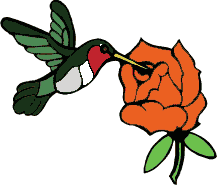 DON'T MISS DON'T MISS"HUMMINGBIRD MORNINGS" |
 HOME: www.hiltonpond.org |
|
||
|
|
|||
|
|
|||
|
|
|||
|
|
|||
|
|
|||
|
THIS WEEK at HILTON POND |
 DON'T MISS DON'T MISS"HUMMINGBIRD MORNINGS" |
|
Sometimes when we go to the woods around Hilton Pond Center, we're delighted by odors that waft across our nostrils: the strong, sweet perfume of the Catalpa tree blossom; the rich smell of soil and humus where an Eastern Chipmunk just extended its burrow; or the aromatic oils given off by Eastern Red Cedars on warm summer days. Each of these odors is a pleasure, and each triggers an almost-lost memory of a time long ago when we experienced that very same odor at some very different place. Occasionally, however, a stench flares our nostrils and we jerk back our head the way we respond to a loud noise, saying "What was that!?" Such was the case along the trail this week when we got close to an Elegant Stinkhorn (Mutinus elegans). The odor of this organism was so powerful we smelled it well before we saw it, and the closer we got the less doubt we had about how appropriately it had been named. 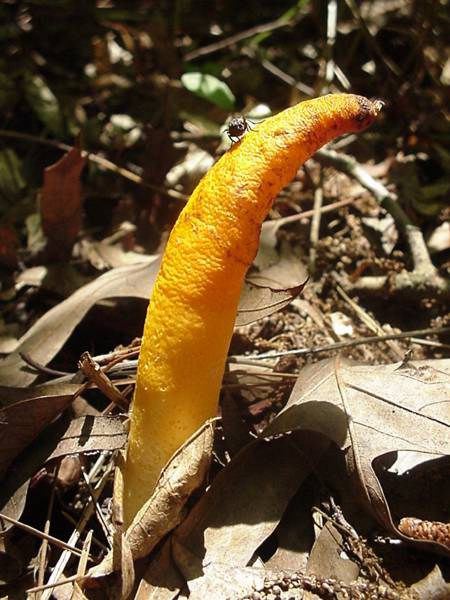 Stinkhorns are a family of mushrooms (the Phallaceae, for their resemblance to a phallus) with varied shapes and colors, but one thing they have in common is a fetid odor reminiscent of rotting flesh. This odor attracts all sorts of scavengers such as flies (photo above), beetles, and even small mammals. To these animals, a stinkhorn probably smells like ambrosia, and they wallow around in pungent ooze the fungus produces. In the process, of course, the scavengers pick up spores that eventually get transferred elsewhere, thus assuring that the stinkhorn populates more distant locales.
Although stinkhorns typically occur in rich, moist soil, some species are so prevalent in plant mulch they become a problem for genteel gardeners with sensitive nostrils. There's nothing like sprucing up the backyard and inviting neighbors over for a cookout, only to find that a dozen stinkhorns have erupted overnight and are producing nauseating odor strong enough to overpower the aroma of hickory smoked hamburgers!
It's times like this we really wish "This Week at Hilton Pond" had a scratch-and-sniff capability so we could share the distinctive odor of Elegant Stinkhorn with everyone who browses our Web site. For the moment, you'll just have to trust us when we say Eau de Stinkhorne isn't likely to show up at the perfume counter of your local department store-- unless it happens to cater to skunks, Turkey Vultures, and Carrion Beetles. As a friend of ours once asked, "Stinkhorns are edible mushrooms, but why on earth would anybody want to eat one?" If you enjoy "This Week at Hilton Pond," please help Support Hilton Pond Center for Piedmont Natural History |
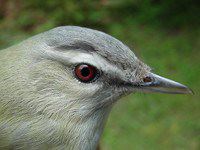 (Young birds have brownish-red eyes that usually change to ruby in adults) The following species were banded this week (22-28 June): Ruby-throated Hummingbird--1* * = At least one Recent Fledgling
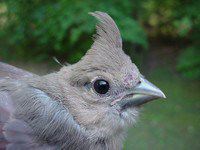 (Like most species, the gape in young cardinals is soft and yellow) |
WEEKLY BANDING TOTAL YEARLY BANDING TOTAL (2001) 63 species 711 individuals BANDING GRAND TOTAL (since 28 June 1982) 122 species 38,994 individuals 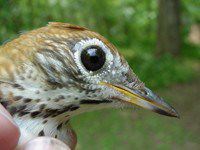 (Most years, a pair nests at 11-acre Hilton Pond Center, but in 2001 there are at least two pairs)
NOTABLE RECAPTURES WITH ORIGINAL BANDING DATES: Northern Cardinal (1) 07/17/94 Eastern (Rufous-sided) Towhee (1) 09/02/99 House Finch (1) 12/10/99 |
|
Up to Top of Page Current Weather Conditions at Hilton Pond Center |
 post questions for The Piedmont Naturalist |
 Nature Study Network |
Hilton Pond Center |
|
|